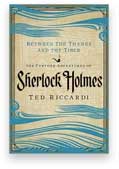Between the Thames and the Tiber
 I don’t like writing negative reviews, especially for a book that seems as promising as Ted Riccardi’s Between the Thames and the Tiber: The Further Adventures of Sherlock Holmes. And it’s made even more disappointing because Riccardi can certainly match Conan Doyle’s style and the friendship between the detective and the doctor.
I don’t like writing negative reviews, especially for a book that seems as promising as Ted Riccardi’s Between the Thames and the Tiber: The Further Adventures of Sherlock Holmes. And it’s made even more disappointing because Riccardi can certainly match Conan Doyle’s style and the friendship between the detective and the doctor.
But unfortunately style alone can’t make a good Holmes story, plot also plays a hand and here many of the stories in this collection of short story pastiches leave you gasping: “It that it! Where’s the rest of the story?” Admittedly it’s a failing that Riccardi shares with Holmes’ creator. As much as I like The Five Orange Pips for example, I still marvel at how Holmes sends the hapless John Openshaw off to his death, reading of his drowning the next day. Doyle obviously had the basis for a great story, but either couldn’t or didn’t want to write a plot that would involve rescuing the man from his fate. And that happens a lot in this collection.
And it is a collection because it ostensibly collects the adventures of Holmes and Watson after the doctor inherits from a relative he didn’t know he had, giving him financial freedom and allowing the two to split their time between Rome and London. But the stories are not in chronological order, and they are self contradictory. In fact one of the stories — The Case of Isadora Persano — seems to directly contradict the story of Watson’s inheritance as explained in the preface.
Several of the stories refer to the breakup of Moriarty’s gang or Moriatry-like gangs — Porlock’s Demise and A Case of Criminal Madness. The latter story also refers to Holmes’ retirement to Sussex and his most unlikely beekeeper’s revenge. I did appreciate Riccardi addressing Holmes’ retirement because it never really made sense to me, but I can’t see the Holmes of Doyle meting out a punishment as in Riccardi’s story. Another story involves Holmes in the events that lead to the First World War, a nice nod to His Last Bow, but involves a ludicrous cypher in the baldly titled The Death of Mycroft Holmes.
Other stories — such as A Singular Event in Tranquebar — left me wondering as to the author’s intent, where I think I know who the murderer is but the story is so odd and disturbing that I would appreciate Holmes coming out and saying it. One thing about a Doyle story: you’re not left wondering who the culprit is. And in several stories, the culprit gets away and is not drowned at sea, as per the usual justice Doyle would devise.
And I’m sorry, you’re not allowed to refer to The Sign of the Four twice in a collection, especially if reusing in the last story — The Mountain of Fear — the exact same name of one of the characters from the first story — An Affair in Ravello — and pretend he’s someone totally different. My husband suggested that maybe Riccardi is subtly playing with perception and reality in these stories, or that they refer to his previous collection, The Oriental Casebook of Sherlock Holmes. If so, the technique is entirely lost on more, the more so because I read at night before I go to sleep and the subtleties are lost upon my tired intellect.
And I also resent the tease of a romance between Holmes and Lady Jennifer Maxwell (who appeared in the Oriental Casebook) in the first story, which remains undeveloped and never mentioned again. Something like a Holmes romance deserves more than just being a plot point. And please, offer translations of all the quotes Holmes is spouting.
OK, I got myself worked up. Despite what is a negative review, I recommend this collection simply because I like just about any Holmes pastiche and Riccardi does capture the style of Holmes, but be forewarned if you read this collection; you may be muttering “What the …” and “How the hell …” and “Did I miss something …” a lot during your reading.
